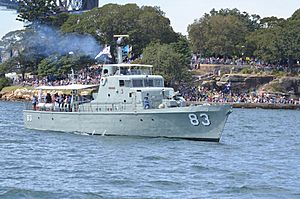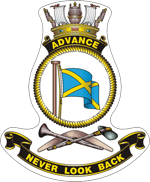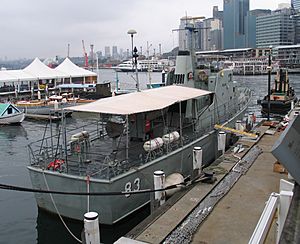HMAS Advance (P 83) facts for kids

HMAS Advance on Sydney Harbour in October 2013
|
|
Quick facts for kids History |
|
|---|---|
| Builder | Walkers Limited, Queensland |
| Laid down | March 1967 |
| Launched | 16 August 1967 |
| Commissioned | 24 January 1968 |
| Decommissioned | 6 February 1988 |
| Motto | "Never Look Back" |
| Status | Museum ship at the Australian National Maritime Museum |
| Badge |  |
| General characteristics | |
| Class and type | Attack-class patrol boat |
| Displacement |
|
| Length | 107.6 ft (32.8 m) length overall |
| Beam | 20 ft (6.1 m) |
| Draught |
|
| Propulsion |
|
| Speed | 24 knots (44 km/h; 28 mph) |
| Range | 1,200 nautical miles (2,200 km; 1,400 mi) at 13 knots (24 km/h; 15 mph) |
| Complement | 3 officers, 16 sailors |
| Armament |
|
HMAS Advance (P 83) was a fast patrol boat used by the Royal Australian Navy (RAN). It was part of the Attack class of ships. It was built in 1967 and started serving in 1968. Advance worked from Darwin, watching over Australia's northern waters.
During its time, Advance followed a Soviet fishing boat, survived a huge storm called Cyclone Tracy, and was even used to film the TV show Patrol Boat. It also helped with the Navy's first anti-terrorism patrol. In 1980, a new ship took its place, but Advance kept going as a training ship until 1988. Today, Advance is a museum ship at the Australian National Maritime Museum, and it can still move on its own!
Contents
Building the Attack Class Patrol Boats
The Attack class patrol boats were ordered in 1964. They were designed to patrol Australian waters. These ships replaced older boats used for patrols, search-and-rescue, and general duties.
The Navy learned lessons from using other ships during the Indonesia-Malaysia Confrontation. This helped them design the new patrol boats. At first, nine ships were ordered for the RAN. Five more were for Papua New Guinea's coastal security force. Later, six more ships were ordered, making a total of twenty Attack class vessels.
What Made Them Special?
These patrol boats were 107.6 feet (about 32.8 meters) long. They weighed 100 tons when empty and 146 tons when fully loaded. They had a beam (width) of 20 feet (about 6.1 meters).
The ships were powered by two large diesel engines. These engines gave them a top speed of 24 knots (about 44 kilometers per hour). They could travel 1,200 nautical miles (about 2,222 kilometers) without needing to refuel. Each ship had a crew of three officers and sixteen sailors.
Weapons and Design Choices
The main weapon on the Attack class boats was a 40 mm gun at the front. They also had two .50 calibre machine guns and other small weapons.
The ships were designed using as many regular, everyday parts as possible. This was important because they would operate in remote areas. If something broke down, it would be easier to find replacement parts in a local hardware store than to wait for special military parts.
Building HMAS Advance
Advance was built by Walkers Limited in Maryborough, Queensland. Its construction started in March 1967. The ship was launched into the water on 16 August 1967. HMAS Advance officially joined the Royal Australian Navy on 24 January 1968. It was the third ship of its kind to be built.
HMAS Advance: A Busy Career
From 1968 to 1980, Advance was based at HMAS Coonawarra in Darwin, Northern Territory. Besides its usual patrol duties, Advance also helped with other important tasks. These included keeping watch, searching for lost people or ships, and mapping the ocean floor.
Following a Soviet Trawler
In 1968, Advance and its sister ship, Attack, had an interesting mission. They spent two months following a Soviet fishing boat called Van Gogh. This trawler was operating in the Gulf of Carpentaria.
Surviving Cyclone Tracy
On 25 December 1974, Cyclone Tracy hit Darwin Harbour. Advance was one of four patrol boats in the harbour that day. Advance and Assail were lucky and did not get badly damaged. However, Attack was pushed ashore and damaged. Sadly, Arrow sank after hitting a wharf.
Fighting Illegal Fishing
In 1975 and 1976, Advance was often part of something called Operation Trochus. This was a big effort to stop illegal fishing boats in Australia's northern waters.
A Star on TV!
From late 1977, Advance moved to HMAS Waterhen in Sydney. It patrolled Australia's eastern coast. In 1979, Advance became a TV star! It was one of two Attack class ships used in the ABC television series Patrol Boat. In the show, Advance played the part of the fictional HMAS Ambush.
Training and Review
In 1980, a newer Fremantle-class patrol boat took Advance's place. But Advance still had an important job. It became a training ship for the Navy. In February 1982, it was assigned to the Sydney Port Division of the Royal Australian Navy Reserve. Advance also took part in the big Naval Review in 1986.
End of Service and Museum Life
HMAS Advance was officially taken out of service on 6 February 1988. After that, it was given to the Australian National Maritime Museum (ANMM).
The museum has done a great job keeping the patrol boat in working condition. This means Advance can still move on its own! In October 2013, Advance even took part in the International Fleet Review 2013 in Sydney. This event celebrated 100 years of the Royal Australian Navy.


